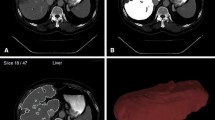Abstract
Purpose
The detection and classification of hepatic vessels in diagnostic images are essential for hepatic pre-surgery planning. Our team has developed a tool for classification, analysis, and 3D reconstruction of the hepatic and portal systems.
Methods
Our software first extracts a graphic representation of a set of connected voxels, representing both systems. It then calculates two binary volumes representing the main part of the two venous systems. Finally, it combines these results to obtain the correct vessel classification.
Results
Segmentation steps are semi-automatic and require about 40 min to complete. Schematization and classification steps are automatic and require about 17 min for results.
Conclusion
The software provides a correct and detailed reconstruction even where pathologies have caused morphological and geometrical variations in the vessels. The time required for the entire procedure is compatible with clinical requirements, providing an efficient tool for diagnosis and surgical planning.
Similar content being viewed by others
References
Couinaud L (1957) Le foie etudes anatomiques et chirurgicales. Masson, Paris, p 11
Meinzer HP et al (2004) Computer-based surgery planning for living liver donation. In: Proceeding of twentieth ISPRS congress Istanbul (Turkey), vol 35, pp 291–296
Selle D et al (2002) Analysis of vasculature for liver surgical planning. IEEE TMI 21(11): 1344–1357
Scheuering M et al (2003) Intraoperative augmented reality for minimally invasive liver interventions. In: Proceeding of SPIE medical imaging, San Diego, USA
Soler L et al (2001) Fully automatic anatomical, pathological and functional segmentation from CT scans for hepatic surgery. Comput Aided Surg 6: 131–142
Homann H et al (2008) Vasculature segmentation of CT liver images using graph cuts and graph based analysis. IEEE ISB 14(17): 53–56
Holman E (1954) The obscure physiology of post-stenotic dilatation: its relation to the development of aneurysms. J Thorac Surg 28: 109–133
Zhou Y, Toga AW (1999) Efficient skeletonization of volumetric objects. IEEE Trans Vis Comput Graph 5(3): 196–209
Shahrokni A et al (2001) Fast skeletonization algorithm for 3-D elongated objects. Medical imaging 2001: image processing. In: Sonka M, Hanson KM (eds) Proceedings of SPIE, San Diego, USA, vol 4322, pp 323–330
Soltanian-Zadeh H et al (2001) Voxel-coding method for quantification of vascular structure from 3D Images. Medical imaging: physiology and function from multidimensional Images. In: Chin-Tu C, Clough AV (eds) Proceedings of SPIE, San Diego, USA, vol 4321, pp 263–270
Dingrong Y, Hayward V (2002) Skeletonization of volumetric angiograms for display. Comput Methods Biomech Biomed Eng 5(5): 329–341
Frag AA et al (2004) Reliable fly-throughs of vascular tree, Technical report. Department of Electrical and Computer Engineering, University of Louisville
Sboarina A et al (2007) Vascular visualization for surgery planning: skeletonization and tubular modeling. In: Proceeding of tenth Israeli symposium on computer-aided surgery, medical robotics, and medical imaging, Haifa, Israel
Sboarina A et al (2008) A tool for vascular disease analysis for intra-operation guide software. In: Proceeding of CARS 2008. Barcellona, Spain, vol 3, suppl 1, pp S103–S104
Giachetti A, Zanetti G (2003) 3D reconstruction of large tubular geometries from CT data. Springer, Berlin. doi:10.1007/3-540-45015-/-13
Author information
Authors and Affiliations
Corresponding author
Rights and permissions
About this article
Cite this article
Sboarina, A., Foroni, R.I., Minicozzi, A. et al. Software for hepatic vessel classification: feasibility study for virtual surgery. Int J CARS 5, 39–48 (2010). https://doi.org/10.1007/s11548-009-0380-4
Received:
Accepted:
Published:
Issue Date:
DOI: https://doi.org/10.1007/s11548-009-0380-4




